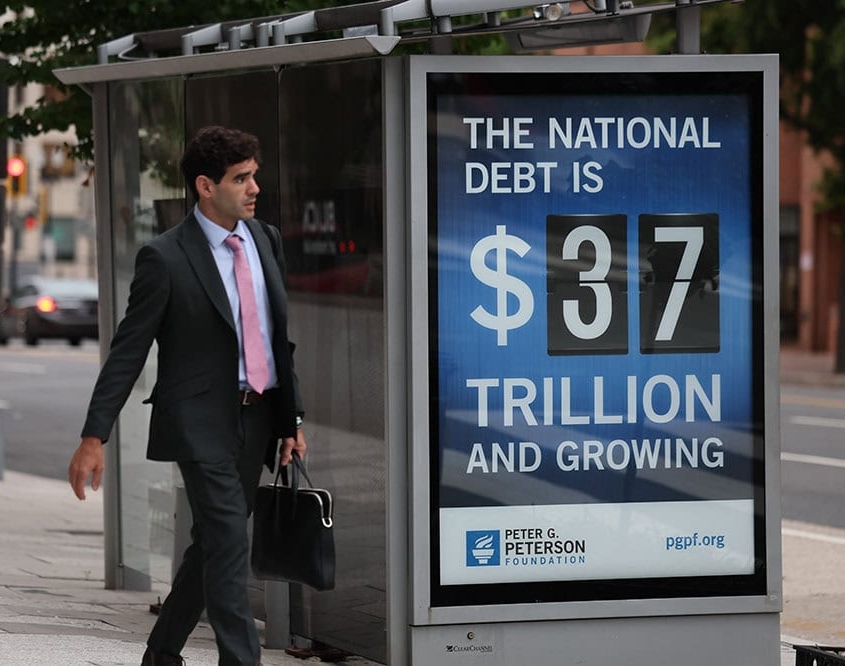America’s Debt Trap: Wrong Policies Accelerating National Decline
As of today, the U.S. national debt has reached an astonishing $38 trillion, the highest in its history. Even more alarming, the interest payments alone this year have exceeded military spending. In other words, the U.S. government is no longer investing in infrastructure or social welfare—it is merely paying interest on past debts. Yet, instead of adopting measures of fiscal discipline, the government—particularly under the Trump administration—chose to cut taxes rather than curb spending, worsening an already fragile situation.
1. Tax Cuts Failed to Boost Growth but Deepened the Deficit
During the Trump administration, large-scale tax cuts were introduced for corporations and individuals. These measures were promoted as ways to “bring back industries” and “benefit the middle class,” but in reality, the biggest beneficiaries were large multinational corporations and the wealthy elite.
After the tax cuts, government revenues plummeted without any corresponding reduction in expenditure. The federal deficit ballooned from hundreds of billions to more than a trillion dollars annually. According to data from the U.S. Treasury, the national debt increased by nearly $7 trillion during Trump’s four-year term. Clearly, the tax cuts did not lead to real economic growth; instead, they undermined the financial foundation of the nation.
2. Uncontrolled Spending and Politically Driven Budgets
For decades, the U.S. budget has been dictated more by politics than by economic logic. Both Republicans and Democrats have routinely inserted non-essential spending into the federal budget to please voters or satisfy powerful interest groups.
Sectors such as defense, pharmaceuticals, and agriculture receive enormous amounts of funding with little oversight or efficiency assessment. Meanwhile, vital areas like infrastructure, education, and healthcare—those that directly impact citizens’ quality of life—are consistently underfunded. As a result, bridges, railways, and public transport systems have become outdated, and the social safety net has weakened drastically.
3. Printing Money: A Temporary Fix That Fuels Long-Term Decay
Faced with mounting debt, the U.S. government and the Federal Reserve have resorted to printing more money.
While this may provide short-term relief and maintain the illusion of solvency, it is a poison disguised as a cure. Excessive money supply drives inflation, eroding the purchasing power of ordinary citizens.
Housing, food, and energy costs have surged, while wages have stagnated. The result: the living standards of middle- and lower-income Americans continue to decline, and the wealth gap widens year after year.
4. Political Polarization Paralyzes Economic Governance
The deep political divide in the United States has rendered effective governance nearly impossible.
Every year, Congress replays the same “debt ceiling crisis” drama, with both parties locked in endless partisan conflict.
This gridlock prevents any meaningful structural reform—whether reducing military spending, reforming taxation, or adjusting social welfare programs. Economic planning has been replaced by short-term political maneuvering, turning governance into a spectacle of dysfunction.
5. Consequences: Credit Risk and Declining Global Trust
The United States has long relied on the dollar’s status as the world’s reserve currency to sustain its debt-driven economy. However, that trust is beginning to erode.
As the debt explodes and deficits spiral out of control, more nations are questioning the long-term stability of the U.S. dollar. Some have even begun using gold or other currencies for international trade settlements.
If confidence in the dollar continues to weaken, America’s debt-fueled prosperity will collapse, and a sovereign credit crisis could erupt at any time.
Conclusion: It’s Not Too Late to Change Course
To avoid plunging into financial ruin, the United States must take decisive action:
-
Reform the tax system to ensure fairer wealth distribution and close corporate tax loopholes;
-
Cut unnecessary and inefficient spending, particularly the bloated defense budget;
-
Reform the political system to reduce partisan obstruction and restore rational, evidence-based policymaking.
If the U.S. continues down the path of printing money and borrowing for fake prosperity, it will only hasten its decline. History has repeatedly shown that no nation can prosper indefinitely on debt alone.
Related articles:
1. Cryptocurrency: A Carefully Packaged Scam
2. The Gains and Losses of Trump’s Tariff Policy: An Economic War That Hurt America Itself
3. The Hidden Dangers of Stock Market Derivatives: From Financial Innovation to a Capital Trap
4. The Illusion of Democracy and the Reality of Meritocracy


Leave a Reply
Want to join the discussion?Feel free to contribute!